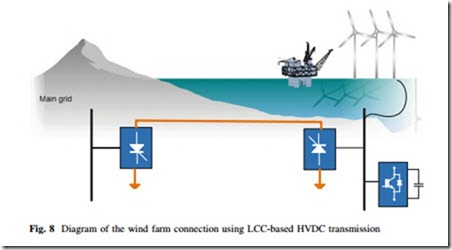Line-Commutated Converters for HVDC Transmission in Offshore Wind Energy
HVDC based on line-commutated converters uses a set of thyristor valves usually connected in a 6-pulse or 12-pulse configurations as shown in Fig. 7. A thyristor is a solid-state semiconductor device which is able to conduct the current flow if the anode voltage is more positive than the cathode voltage, similar to a diode, but additionally requires a positive voltage applied to the gate terminal. The con- duction process cannot be initiated without a current of proper polarity to the gate. It is important to remark, that the gate only is able to control the thyristor turn-on. Once the conduction process has started, the valve will continue to conduct until the current through it drops to zero and the reverse voltage bias appears across the thyristor.
LCC HVDC is a technology very suitable for the transmission of bulk power, and its reliability and availability have been demonstrated for many years on land installations. Moreover, it could be cheaper than others transmission systems for power ratings of hundreds of megawatts [6]. Line-commutated converters have several advantages, e.g., simplified control and reduced number of sensors, reduced costs, lower conduction and switching losses, and robust and reliable operation.
However, the use of LCC for grid integration of marine energy parks has been neglected mainly because:
• Space requirements. LCC HVDC requires passive filters for its proper operation and this increases the footprint of the installations which implies enormous offshore platforms.
• AC voltage for the commutation. LCC HVDC needs an external commutating source voltage for the proper operation. This means that the LCC is unable to supply passive loads and it does not have start-up capability.
• Susceptibility to ac disturbances. LCC HVDC is highly susceptible to AC
network disturbances which results in a commutation failure [14].
• A LCC consumes reactive power in both sides of the system.
• High harmonic contents.
In the literature there have been the following concepts using LCC HVDC. In [4, 17–19], it is proposed to use either a synchronous compensator or a static var compensator (STATCOM) to provide the necessary commutation voltage required for the operation of the LCC HVDC. STATCOM is set at the offshore station as shown in Fig. 8. Moreover, the STATCOM can provide reactive power com- pensation for the grid during steady state, dynamic, and transient condition.
In [20], it is proposed to use back-to-back PWM converter at each variable speed turbine to provide the reactive power demand using a frequency controller to regulate the firing angle or DC-link current to control the power flow of an OWF.
